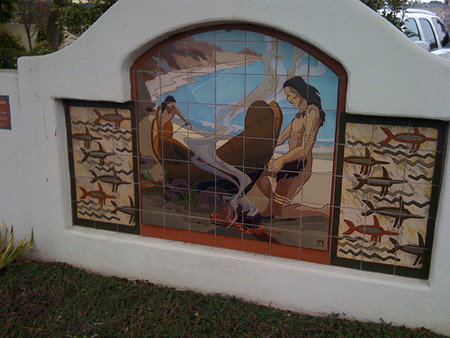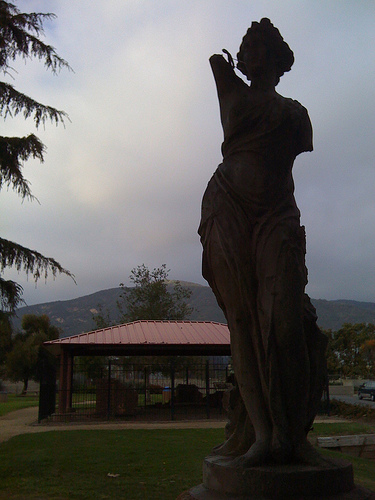The Carpinteria school board is meeting Tuesday night to rule on the Native American imagery issue. As anyone who has lived in Carp over the last year knows, the question of what to do about the schools’ “warrior” mascot has generated a lot of controversy. Media outlets beyond Carpinteria have taken notice; see Steve Chawkins’ recent article in the LA Times (In Carpinteria, a battle over a high school’s symbols), or Cathy Murillo’s article in The Independent (Carpinteria School Board to Decide Mascot Issue).
One piece of Native American imagery that has figured prominently in the controversy is the Indian-head bust at the entrance to the high school. It was a gift from the graduating class of 1970. Here’s a photo of it taken by flickr user kbaird:
Making a work of art using stone (or at least, something approximately stone-like; I’m not sure exactly how the warrior head at Carp High was constructed) is an interesting choice. It’s certainly not the easiest medium to work in. But on the other hand, the results of your work can survive for a long time. There’s a risk in that; the social context in which your work is interpreted can evolve in directions you didn’t anticipate. I was thinking about issues like that as I snapped the following photos of public statuary in Carp during some walks over the last month or so.
Here’s the seal fountain on Linden in front of Von’s. It might not be the most anatomically-correct representation of a seal, but it’s a cute fountain:
Here’s the newer seal statue, with mother and pup, that was just installed at the ocean end of Linden:
Linda makes fun of the dorky expressions on the faces of these seals, but I don’t know; I think the artist did a pretty good job of capturing the expression that harbor seals naturally have.
Not a statue per se, but I like this tile mural of a Chumash tomol being caulked with naturally occurring tar. As most Carp residents know, the city got its current name when Spanish explorers saw this activity taking place, and named the location La Carpinteria (the carpenter shop). The mural is at the corner of Linden and Eighth Street:
Yesterday William and his buddy Spencer were rotting their brains with the Xbox, and at a certain point I got tired of listening to them kill each other and mandated a trip to the park. They seemed (to my admittedly prejudiced eye) to be having just as much fun racing parkour-style through the play structure, and it gave me a chance to pop over and get a few photos of another statue.
This was at the Heath Ranch Park (which I and pretty much everyone else call Eucalyptus Park, for the huge trees that survive from those that originally lined the driveway of the Heath’s Victorian house). When the Heath home was being demolished, the remains of the original adobe home it was built around were discovered, and those remains were preserved. If you visit the display and look carefully at the photo in the interpretive sign, you can see the graceful statue that stood in the fountain in front of the Victorian house:
The fountain no longer operates, but the statue is (mostly) still there, a reminder to artists who choose to work in stone: Do your best work. It might outlast you.





